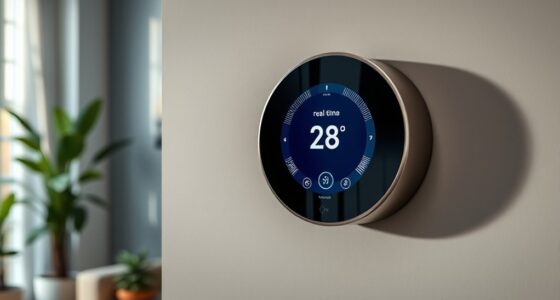Using occupancy-based scheduling helps you save energy by automatically adjusting lighting, heating, and cooling based on real-time space usage. When rooms are unoccupied, systems turn off or scale back, reducing waste and cutting costs. By utilizing smart sensors, you can customize schedules to fit user patterns, maintaining comfort while optimizing efficiency. This proactive approach not only lowers energy bills but also supports sustainability goals. To discover how to implement these strategies effectively, continue exploring the possibilities.
Key Takeaways
- Automate lighting, heating, and cooling based on real-time occupancy data to reduce energy waste.
- Analyze occupancy patterns to optimize schedules and avoid unnecessary energy use during low-occupancy periods.
- Use smart sensors to accurately detect presence, ensuring comfort while minimizing false triggers.
- Collect occupancy data to identify inefficiencies and continually improve building energy management.
- Support sustainability goals by decreasing overall energy consumption and environmental impact through intelligent scheduling.

Many buildings waste energy by keeping lights, heating, and cooling systems on when spaces are unoccupied. This unnecessary energy use not only increases costs but also harms the environment. To combat this, occupancy-based scheduling offers a smart solution. By leveraging smart sensors, you can automatically detect whether a room or space is in use. These sensors gather real-time data on user behavior, allowing your building management system to adjust energy consumption accordingly. When no one is around, lights turn off, and HVAC systems ramp down, saving significant amounts of energy without sacrificing comfort or productivity.
Smart sensors detect occupancy, enabling automatic adjustments that save energy and enhance building efficiency.
Smart sensors are the backbone of effective occupancy-based scheduling. They are small, unobtrusive devices that detect movement, sound, or even body heat. You don’t need to remember to turn off lights or adjust thermostats manually, because these sensors do it automatically based on actual occupancy. This automation guarantees that energy isn’t wasted during unoccupied periods, which are often overlooked in traditional scheduling. Plus, modern sensors are highly accurate, minimizing false triggers that could lead to discomfort or energy waste. Over time, these sensors learn user behavior patterns, making the system even more efficient. Additionally, integrating energy-efficient technology further enhances overall savings and sustainability.
Understanding user behavior is vital for optimizing occupancy-based scheduling. For instance, if you notice that a conference room is rarely used after 6 p.m., the system can automatically reduce heating, cooling, and lighting during those hours. Conversely, if a space is frequently occupied during specific times, the system can preemptively prepare the environment, ensuring comfort when needed. This dynamic approach adapts to your building’s unique usage patterns, avoiding the one-size-fits-all approach of traditional schedules. As a result, you save energy while maintaining a high level of comfort for occupants.
Implementing occupancy-based scheduling also encourages better user behavior. When people know that lights and climate controls respond automatically, they tend to be more conscious of their own energy use. Additionally, with data collected from smart sensors, facility managers can identify inefficiencies or patterns that require adjustments. This feedback loop helps fine-tune the system, leading to ongoing energy savings.
In the end, occupancy-based scheduling powered by smart sensors and informed by user behavior transforms how your building consumes energy. It’s a proactive, intelligent approach that reduces waste, cuts costs, and promotes sustainability—all while keeping occupants comfortable. By embracing this technology, you’re not just managing energy better; you’re making a positive impact on the environment and your bottom line.
Frequently Asked Questions
How Accurate Is Occupancy Detection in Various Environments?
Occupancy detection accuracy varies depending on the environment, but with good sensor calibration, you can expect high detection reliability. In busy or complex spaces, sensor accuracy might dip slightly due to overlapping signals or obstructions. You should regularly test and adjust sensors to maintain detection reliability, especially in challenging settings like large open areas or crowded rooms. Overall, with proper setup, occupancy detection can be quite precise across different environments.
What Are the Privacy Concerns With Occupancy Sensors?
You’re probably worried that occupancy sensors invade your privacy or compromise data privacy. While these sensors can seem like a giant eye watching every move, their main concern is data privacy—collecting minimal data and often anonymized. However, sensor vulnerabilities exist, risking unauthorized access or misuse. To protect yourself, guarantee your system uses robust security measures, and stay informed about how your data is collected and stored.
Can Occupancy Scheduling Adapt to Unexpected Occupancy Changes?
Yes, occupancy scheduling can adapt to unexpected changes by utilizing sensor calibration and data integration. When sensors are properly calibrated, they accurately detect occupancy variations, allowing the system to respond in real-time. By integrating data from different sensors and sources, you guarantee the scheduling adjusts dynamically, maintaining energy efficiency and comfort. This proactive approach helps prevent energy waste while accommodating unforeseen occupancy patterns effectively.
What Are the Initial Costs Versus Long-Term Savings?
You’ll find that initial costs for occupancy-based scheduling include equipment upgrades and system integration, but a thorough cost analysis shows these are offset by significant long-term savings. The savings projection reveals reduced energy consumption, lower utility bills, and improved efficiency over time. While upfront investments may seem high, the ongoing energy savings make this approach cost-effective, ultimately delivering a strong return on your investment.
How Does Occupancy Scheduling Integrate With Existing Building Management Systems?
You can integrate occupancy scheduling with your existing building management systems by connecting sensors that monitor occupancy levels and calibrating them accurately. This involves sensor calibration to guarantee data accuracy and seamless data integration with your system’s software. Once integrated, your management system can automatically adjust lighting, HVAC, and other systems based on real-time occupancy data, optimizing energy use and enhancing comfort efficiently.
Conclusion
So, next time you leave the office early, remember that occupancy-based scheduling is secretly plotting to save energy—and maybe even your conscience. By simply letting sensors do the work, you can enjoy guilt-free efficiency while the building quietly flexes its eco-muscles. Who knew that saving the planet could be as easy as walking out the door? Embrace these clever systems; after all, they’re the real heroes, while you take all the credit.









